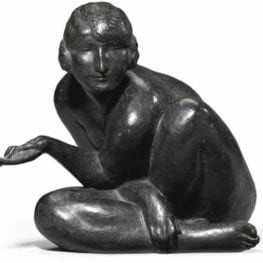Cecil Howard
1888–1956
Cecil de Blaquiere Howard, sometimes Cecil Howard, (April 2, 1888 – September 5, 1956), born in Clifton, Welland County, Ontario, Canada (today Niagara Falls) was an American painter and sculptor.
Howard was the fourth child of British businessman George Henry Howard (1840-1896) and his wife Alice Augusta (née Farmer, 1850-1932). As the youngest son, Cecil was given his maternal grandmother’s name “de Blaquiere” as his middle name. The family moved to Buffalo (New York) in 1890, and took American citizenship in 1896.
Howard left school early to study with James Earle Fraser at the Art Students’ League of Buffalo, which had recently relocated into the basement of the Albright–Knox Art Gallery, still under construction.
At the early age of sixteen, he traveled to Paris to study at the Académie Julian with Raoul Verlet. Soon he befriended Rembrandt Bugatti, whom he accompanied in 1909 on a journey to Antwerp, where together they made drawings and sculptures of animals in the Zoological Garden. Howard presented these early pieces at the Salon d’Automne in 1910, but later destroyed many of these plasters, as he regarded them as inferior in comparison to Bugatti’s works. After his return from Holland, the sculptor moved to a studio on the Avenue du Maine, in Montparnasse, and regularly presented his works in Parisian salons and galleries. In 1913, Howard presented one of his earlier female nudes, simply entitled Woman, at the Armory Show in New York and Boston. This was his first exhibition in the United States.
In the early days of World War I, Howard served in an Anglo-French hospital as a stretcher-bearer, and in 1915 he joined an English Red Cross unit heading for Serbia, ravaged by war and typhus.[10] At the end of his six months engagement, he was back in Paris, and went on to produce a series of polychrome cubist sculptures, mainly inspired by scenes in Parisian dance-halls. By October 1915, after ten years in France, Howard returned to the United States for the annual exhibition of American sculpture at the Gorham Galleries in New York. Four months later, after a few sales, he was back in Paris. In November 1916 he featured again in the annual exhibition at the Gorham Galleries, where he presented Decorative Figure, a sculpture of a tall African woman bearing a vase on her shoulder, and L’Après-midi d’un faune (Afternoon of a Faun), representing two dancers, inspired by Nijinsky’s innovative ballet. Both pieces were exhibited the following months at the National Academy in Manhattan and at the Pennsylvania Academy of the Fine Arts of Philadelphia. In 1917, Howard befriended the poet and critic Guillaume Apollinaire and in June of that year he played the role of the People of Zanzibar, providing on-stage accordion music and sound-effects, in the première of Apollinaire’s «surrealist drama» Les Mamelles de Tirésias.

